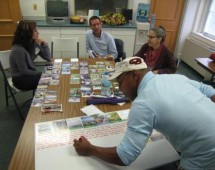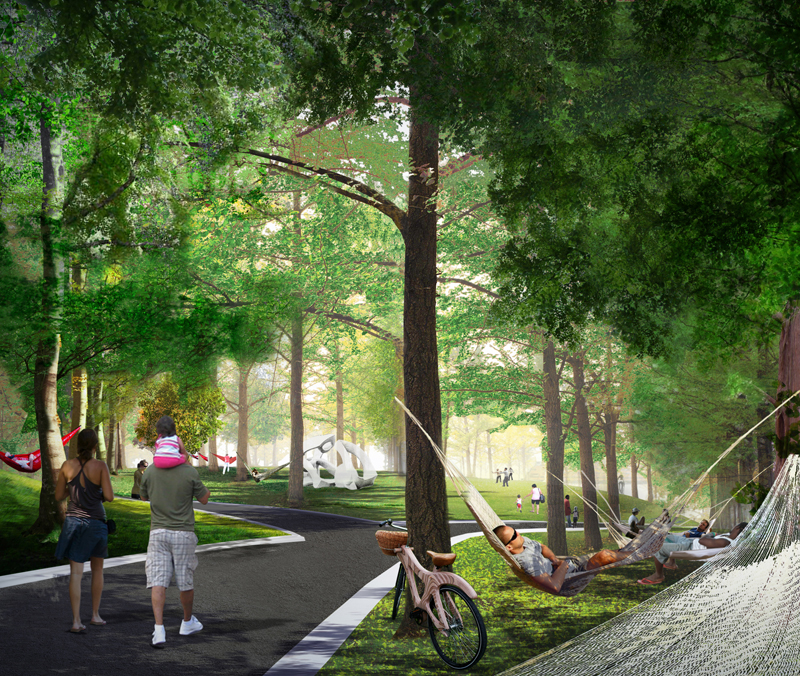
We are celebrating 15 years — and counting — of stories that are deeply researched and deeply felt, that build a historical record of what the city has been.
We are celebrating 15 years — and counting — of stories that are deeply researched and deeply felt, that build a historical record of what the city has been.
Community board review, surveys, neighborhood impact assessments, public hearings. Traditional methods of soliciting public input on major design projects can be a little dry and uninspiring. And that’s if you even know about them — public participation is often limited to those motivated few who know to show up and have the time to do so. But when a project — say, a new public park on a 172-acre island in New York Harbor — requires a ferry ride to visit, the vitality of the space depends on getting people to show up. So, how do you create a destination? The answer might be as simple as this: ask people what they want, make it easy for them to tell you, and then give it to them. That’s the theory behind the extensive public outreach effort that led up to and is now responding to the Governors Island Park and Public Space Master Plan, an effort masterminded by Leslie Koch, President of the Governors Island Preservation and Education Corporation (GIPEC). We sat down with Koch in Building 110 on Governors Island, where visitors can view and respond to an exhibition of the master plan, to talk about the ideas and efforts put into envisioning New York City’s future island oasis: the outreach methods they employed, the challenges of identifying an audience for a park on an island with no existing constituency, why designers need to engage with the public, and how Post-it notes and hammocks can lead to the thoughtful design of public space. Listen to her thoughts below:
For nearly two centuries, Governors Island was used as a military base. In the mid 1990s, when the Coast Guard closed its operations on the island, interest developed in identifying a public use for the island. Beginning in 1995, a coalition of civic groups called the Governors Island Alliance, along with local community boards, elected officials and other interested parties, worked to build public support for the transfer of the island from the Federal to the State and City Governments and to solicit public input on how the island should be developed and used. The State and City of New York co-purchased the land (at a cost of $1) from the Federal Government in 2003 with goals of revitalization and development. (Earlier this year the State relinquished control to the City after ongoing funding problems impeded progress.)
In 2006, Leslie Koch was appointed President of GIPEC, the agency responsible for the planning, redevelopment and operations for 150 acres of Governors Island (the remaining 22 acres are designated as a national monument and are thus operated by the National Park Service). She has since led the charge to “bring Governors Island back to life” and put into motion the process of creating a vision for its future; a process that encompasses everything from designing a park in the 100-year flood zone (the first project in New York City designed with climate change in mind, according to Koch) to reminding New Yorkers of the majesty of the Statue of Liberty (just for tourists you say? Take a look at it from Picnic Point).
 In the fall of 2006, GIPEC launched a design competition for a preliminary vision of the park. Five teams were selected and the call for public response began. The teams’ ideas were presented as part of two exhibitions (one on the island and one at the Center for Architecture), a public forum, public tours and online. The success of the public feedback effort and its impact on the jury process encouraged Koch to pursue similar methods once the winning team was chosen – West 8, led by Adriaan Geuze, with Diller Scofidio + Renfro, Mathews Nielsen and Rogers Marvel – and they began work on the master plan. Online and off, on the island and around the city, using photo booths and rubber stamps, the team took great strides to discover what New Yorkers are looking for in their recreation space.
In the fall of 2006, GIPEC launched a design competition for a preliminary vision of the park. Five teams were selected and the call for public response began. The teams’ ideas were presented as part of two exhibitions (one on the island and one at the Center for Architecture), a public forum, public tours and online. The success of the public feedback effort and its impact on the jury process encouraged Koch to pursue similar methods once the winning team was chosen – West 8, led by Adriaan Geuze, with Diller Scofidio + Renfro, Mathews Nielsen and Rogers Marvel – and they began work on the master plan. Online and off, on the island and around the city, using photo booths and rubber stamps, the team took great strides to discover what New Yorkers are looking for in their recreation space.
The views expressed here are those of the authors only and do not reflect the position of The Architectural League of New York.


Comments